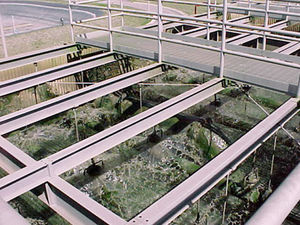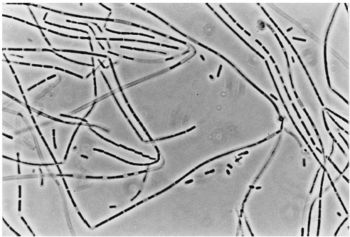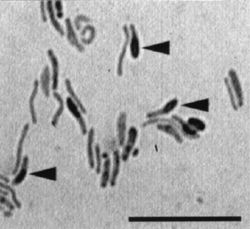Sphaerotilus
A Microbial Biorealm page on the genus Sphaerotilus
Classification
Higher order taxa:
Bacteria; Proteobacteria; Betaproteobacteria; Burkholderiales; unclassified Burkholderiales; Burkholderiales Genera incertae sedis
Species:
Sphaerotilus natans, S. sp.
|
NCBI: Taxonomy Genome |
Description and Significance
Sphaerotilus natans is a filamentous bacterium that is covered in a tubular sheath and can be found in flowing water and in sewage and wastewater treatment plants. While this bacterium sometimes clogs pipes and causes other similar problems, it does not cause major threat to wastewater treatment plants nor is it known to be pathogentic.
Genome Structure
No Sphaerotilus genomes have been sequenced at this time.
Cell Structure and Metabolism

Sphaerotilus natans is a filamentous bacterium characterized by its rod-shaped cell that is enclosed by a tubular sheath. Sphaerotilus bacteria grow well under low oxygen concentrations and are able to utilize many different types of organic carbon compounds: they can metabolize polysaccharides, sugars, polyalcohols, or organic acids as carbon sources. The Sphaerotilus natans swarmer cells have a polar organelle at the flagellated pole located near the cytoplasmic membrane next to its flagella (Lybarger and Maddock, 2001). The nonmotile cells do not have this organelle.
Ecology
Sphaerotilus natans can be mainly found in flowing water, sewage, and activated sludge. It has been known to cause such problems as pipe clogging and "bulking of activated sludge in wastewater treatment" due to its ability to settle on a solid surface by entanglement or by using an adhesive basal element on one end of the filament (Pellegrin et al. 1999). In addition, strains of filamentous bacteria were isolated from paper mill slimes that had morphological and physiological characteristics of Sphaerotilus. However, these isolates could grow at tempuratures up to 40oC, which is higher than Sphaerotilus natans's normal tempurature.
Sheath-Degrading Microorganisms
Microorganisms have been collected from the soil and river water that are able to degrade and grow on the purified sheath of Sphaerotilus natans. Two bacterial strains, called TB and TK, are rod shaped, negatively stained by gram staining, faculatitvely anaerobic, and formed ellipsoidal endospores: these defining characteristics suggested that the bacteria belong to the genus Paenibacillus according to some researchers. The enzyme that was responsible for the sheath-degrading was at optimal activity at pH 6.5 to 7.0 and 30 to 40C. The ions Mg2+, Ca2+, Fe3+, and iodoacetamide accelerated the sheath-degrading reaction and Cu2+, Mn2+ and dithiothreitol inhibited the reaction. The enzyme itself "acted on the polysaccharide moiety of the sheath, producing an oligosaccharide the size of which was between the sizes of maltopentaose and maltohexaose" (Takeda et al. 2000).
References
General:
- Pellegrin, Veronique, Stefan Juretschko, Michael Wagner, and Gilles Cottenceau. 1999. "Morphological and biochemical properties of a Sphaerotilus sp. isolated from paper mill slimes." Appl Environ Microbiol, vol. 65, no. 1. American Society for Microbiology. (156-162)
Cell Structure and Metabolism:
- Lybarger, Suzanne R. and Janine R. Maddock. 2001. "Polarity in action: Asymmetric protein localization in bacteria." J Bacteriol, vol. 183, no. 11. American Society for Microbiology. (3261-3267)
Sheath-Degrageding Microorganisms:
- Takeda, Minoru, Keishi Iohara, Sachie Shinmaru, Ichiro Suzuki, and Jun-Ichi Koizumi. 2000. "Purification and properties of an enzyme capable of degrading the sheath of Sphaerotilus natans." Applied and Environmental Microbiology, vol. 66, no. 11. American Society for Microbiology. (4998-5004)


